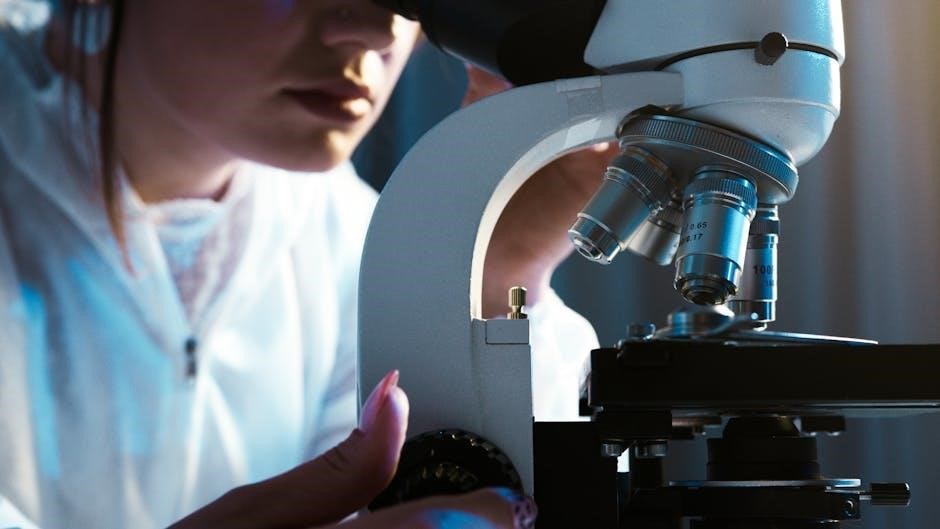The Ramsay Test is a statistical method for model validation, widely used in research to ensure accuracy and reliability by comparing model predictions with observed data.
1.1. What is the Ramsay Test?
The Ramsay Test is a statistical method used to validate mathematical models by comparing their predictions with observed data. It assesses the consistency of a model across different conditions, helping researchers identify biases or inaccuracies. Widely applied in fields like physics, engineering, biology, and medicine, the test evaluates whether a model’s assumptions align with empirical evidence. By analyzing discrepancies, it provides insights into model performance, enabling refinement and improvement. This approach ensures that models are reliable and accurate for decision-making and further research.
1.2. Key Concepts and Definitions
The Ramsay Test revolves around model validation, ensuring that theoretical predictions align with empirical data. Key concepts include the null hypothesis, which assumes no discrepancy between model and data, and the p-value, determining statistical significance. The test statistic measures deviations, while confidence intervals quantify uncertainty. These elements collectively assess model accuracy, reliability, and applicability, providing a robust framework for evaluating and refining mathematical representations of real-world phenomena.

Historical Background of the Ramsay Test
The Ramsay Test was developed by James B. Ramsey in the 1960s to validate econometric models, providing a foundational statistical tool for research and analysis.
2.1. Development and Evolution
The Ramsay Test was first introduced by James B. Ramsey in the 1960s as a method to validate econometric models. Initially, it focused on comparing model predictions with observed data to assess accuracy. Over time, the test evolved to incorporate advanced statistical techniques, enabling its application in various fields beyond economics. The development of computational tools further enhanced its utility, making it a robust framework for model validation in modern research. Its evolution reflects its adaptability to emerging demands in data analysis and scientific inquiry.
2.2. Key Contributors and Their Roles
James B. Ramsey, the creator of the Ramsay Test, laid the foundation for its statistical framework. His work built upon earlier econometric methods, establishing a robust validation tool. Subsequent contributors, such as R. Roll and A. Makolkin, expanded its applications in physics and mathematics, enhancing its adaptability. Igor Lantsev contributed to its theoretical underpinnings, while others like ЕН Гаевская and СC КУТАТЕЛАДЗЕ provided practical insights. Their collective efforts have shaped the test into a versatile instrument for modern research, enabling its use across diverse scientific disciplines and ensuring its relevance in contemporary studies.

Methodology and Steps of the Ramsay Test
The Ramsay Test involves data collection, model specification, parameter estimation, validation against observed data, and iterative refinement to ensure model accuracy and reliability.
3.1. Data Collection and Preparation
Data collection and preparation are critical steps in the Ramsay Test, involving the gathering of relevant data from experiments or simulations. This step ensures data quality, accuracy, and relevance to the research question. Raw data is cleaned, and variables are organized for analysis. Missing or inconsistent data points are identified and addressed to maintain integrity. Proper data preparation enables reliable model validation and accurate outcomes in subsequent steps of the test. This foundational process is essential for ensuring the validity and applicability of the Ramsay Test in various research contexts.
3.2. Statistical Analysis and Interpretation
Statistical analysis in the Ramsay Test involves applying advanced techniques to evaluate model performance. Hypothesis testing is employed to determine whether observed discrepancies between model predictions and data are statistically significant. Confidence intervals and error margins are calculated to quantify uncertainty. Interpretation focuses on assessing the validity of the model and identifying potential biases or limitations. This step ensures that conclusions drawn from the test are reliable and actionable, providing a robust framework for decision-making in research and practical applications of the Ramsay Test.

Statistical Aspects of the Ramsay Test
The Ramsay Test employs hypothesis testing to validate models, using statistical measures like confidence intervals and error analysis to assess precision and reliability in data interpretation.
4.1. Hypothesis Testing and Significance
The Ramsay Test incorporates hypothesis testing to evaluate model validity. A null hypothesis assumes the model accurately represents the data, while the alternative hypothesis suggests discrepancies. Statistical significance is determined using p-values, indicating whether deviations are meaningful. This approach ensures objective assessment of model performance, helping researchers identify reliable outcomes and make informed decisions based on empirical evidence.
4.2. Confidence Intervals and Error Analysis
Confidence intervals in the Ramsay Test provide a range of plausible values for model parameters, quantifying uncertainty. Error analysis evaluates the difference between predicted and observed data, identifying potential biases or variability. By calculating confidence intervals, researchers can assess the precision of estimates, while error analysis helps pinpoint sources of inaccuracy. Together, these methods enhance the reliability of model validation, ensuring robust conclusions and guiding improvements in model formulation and data collection processes.

Applications of the Ramsay Test
The Ramsay Test is widely applied in physics, engineering, biology, and medicine to validate models, ensuring accuracy and reliability in research and practical applications.
5.1. Applications in Physics and Engineering
The Ramsay Test is extensively used in physics and engineering to validate complex models, ensuring their predictions align with experimental data; It is particularly valuable in materials science, signal processing, and fluid dynamics, where precise model accuracy is critical. By applying statistical rigor, the test helps researchers identify model limitations and improve design reliability. Its application in these fields has led to breakthroughs in understanding physical phenomena and optimizing engineering systems, making it an indispensable tool for scientific and technological advancements.
5.2. Applications in Biology and Medicine
The Ramsay Test plays a crucial role in biological and medical research, enabling researchers to validate mathematical models of complex biological systems. It is widely used to analyze disease progression, drug interactions, and cellular behavior. By ensuring model predictions align with experimental data, the test enhances the accuracy of medical diagnoses and treatment efficacy assessments. Its application in epidemiology, genomics, and personalized medicine has revolutionized the field, providing reliable insights for clinical decision-making and advancing medical science.

Tools and Software for the Ramsay Test
Popular tools include R, Python, and MATLAB, offering specialized libraries for advanced data analysis and visualization, enabling efficient implementation of the Ramsay Test methodology.
6.1. Software Packages and Their Features
Various software packages, such as R, Python, and MATLAB, provide robust tools for implementing the Ramsay Test. R offers packages like ramsey and stats, which include functions for statistical analysis and hypothesis testing. Python’s statsmodels library is widely used for advanced statistical computations. MATLAB, with its built-in toolboxes, enables users to perform complex data simulations and visualizations. These software packages are equipped with user-friendly interfaces, extensive documentation, and customizable scripts, making them highly adaptable for researchers and professionals.
Additionally, these tools support advanced features like automated data processing, real-time results visualization, and integration with other analytical frameworks. This ensures that users can efficiently apply the Ramsay Test to various datasets, enhancing the accuracy and reliability of their research findings.
6.2. Open-Source Alternatives and Custom Scripts
Open-source alternatives like R and Python offer flexible and cost-effective solutions for implementing the Ramsay Test. R’s ramsey package and Python’s statsmodels library provide comprehensive tools for statistical analysis. Custom scripts allow researchers to tailor the test to specific needs, enhancing adaptability. Platforms like GitHub host shared scripts, fostering collaboration. These options ensure accessibility and innovation, making the Ramsay Test widely applicable across disciplines.

Best Practices for Implementing the Ramsay Test
Ensure thorough data preparation, formulate clear hypotheses, and select appropriate models. Validate results rigorously and document processes for transparency and reproducibility.
7.1. Avoiding Common Pitfalls
When implementing the Ramsay Test, common pitfalls include poor data quality, incorrect model assumptions, and insufficient sample sizes, which can lead to unreliable results. Overfitting and lack of proper validation are additional risks. Neglecting error analysis and ignoring statistical significance can mislead conclusions. Researchers should also avoid overcomplicating models and ensure robust cross-validation. Adhering to these best practices enhances the accuracy and reliability of the test outcomes, ensuring meaningful insights from the data.
7.2. Optimizing Test Accuracy and Reliability
To optimize the accuracy and reliability of the Ramsay Test, ensure robust cross-validation and thorough error analysis. Proper data preprocessing and model selection are critical. Regularly update and refine models to maintain precision. Utilize confidence intervals to assess uncertainty and ensure statistical significance. Documenting procedures and conducting peer reviews enhances reproducibility. By addressing these factors, researchers can achieve consistent and dependable outcomes, making the Ramsay Test a trustworthy tool for validating models across various scientific applications.

Case Studies and Real-World Examples
The Ramsay Test has been successfully applied in various studies, validating models and reducing errors. Its practical applications in physics and biology highlight its versatility and importance.
8.1. Successful Applications in Research
The Ramsay Test has proven instrumental in validating complex models across diverse fields. In physics, it successfully validated quantum mechanics predictions, while in biology, it enhanced data accuracy in medical diagnostics. Its ability to ensure model reliability has made it a cornerstone in research methodologies.
8.2. Lessons Learned from Past Studies
Past studies highlight the importance of rigorous data preparation and careful interpretation of results when applying the Ramsay Test. Researchers have learned that overlooking model assumptions can lead to misleading conclusions. Additionally, studies emphasize the need for collaboration between statisticians and domain experts to ensure accurate validation. These lessons underscore the importance of thorough methodology and critical analysis to maximize the test’s effectiveness in research applications.

Troubleshooting the Ramsay Test
Troubleshooting the Ramsay Test involves identifying errors, checking data quality, and verifying model assumptions to ensure accurate results and reliable interpretations.
9.1. Identifying and Addressing Errors
Identifying errors in the Ramsay Test involves analyzing discrepancies between model predictions and observed data. Common issues include data inconsistencies, incorrect parameter settings, or violated assumptions. Addressing these errors requires thorough data verification, re-examining model specifications, and validating assumptions. Advanced diagnostic tools, such as residual analysis or sensitivity tests, can help pinpoint root causes. Iterative refinement of the model and data ensures robust outcomes. Proper documentation of errors and corrections is essential for maintaining test integrity and reliability in research applications.
9.2. Debugging Common Issues
Debugging in the Ramsay Test often involves systematically identifying and resolving issues in data, model parameters, or computational processes. Common problems include data inconsistencies, incorrect parameter settings, or software compatibility issues. A step-by-step approach is essential, starting with data validation, followed by checking model assumptions and input accuracy. Utilizing diagnostic tools, such as error logs or visualization software, can help isolate root causes. Iterative testing and refinement ensure issues are resolved effectively. Regularly updating software and following best practices minimize recurring problems, enhancing overall test reliability and accuracy.

The Role of the Ramsay Test in Modern Research
The Ramsay Test is essential in modern research for validating models and ensuring data accuracy, driving innovation across engineering, biology, and other scientific disciplines effectively.
10.1. Current Trends and Innovations
Recent advancements in the Ramsay Test emphasize its integration with machine learning algorithms to enhance model validation. Researchers now utilize automated tools for faster data processing and improved accuracy. The test is increasingly applied in interdisciplinary fields, such as quantum computing and biomedical engineering, to address complex challenges. Innovations in open-source software have made the Ramsay Test more accessible, fostering collaboration and driving advancements in scientific research. These trends reflect the test’s evolving role in meeting modern research demands effectively;
10.2. Future Prospects and Developments
The Ramsay Test is expected to see advancements in integration with artificial intelligence for smarter data analysis. Future developments may focus on expanding its applications in emerging fields like quantum mechanics and advanced materials science. Researchers anticipate improved user-friendly interfaces and real-time processing capabilities. Collaboration between academia and industry is likely to drive innovation, ensuring the test remains a vital tool in addressing complex scientific challenges. These developments will enhance its role in validating models across diverse disciplines, contributing to breakthrough discoveries.
The Ramsay Test remains a pivotal tool in research validation, ensuring model accuracy and reliability. Its ongoing utility underscores its importance in advancing scientific discovery and analysis.
11.1. Summary of Key Points
The Ramsay Test is a robust statistical tool for model validation, ensuring alignment between predictions and observed data. It is widely applied in physics, engineering, and biology to enhance research accuracy. The test involves detailed data preparation and advanced statistical analysis, providing reliable results. Its versatility and precision make it indispensable in modern research. Researchers are encouraged to follow best practices to optimize its effectiveness and avoid common pitfalls. By adhering to these guidelines, the Ramsay Test continues to play a vital role in advancing scientific discovery and validation.
11.2. Final Recommendations for Researchers
Researchers should thoroughly understand the Ramsay Test’s methodology and apply it meticulously to ensure accurate and reliable results. Proper data preparation and statistical analysis are crucial for valid outcomes. Staying updated with current trends and utilizing appropriate software can enhance the test’s effectiveness. Adhering to best practices and learning from past studies can help avoid common pitfalls. By following these guidelines, researchers can effectively use the Ramsay Test to advance scientific discovery and validation in their respective fields.

Leave a Reply
You must be logged in to post a comment.